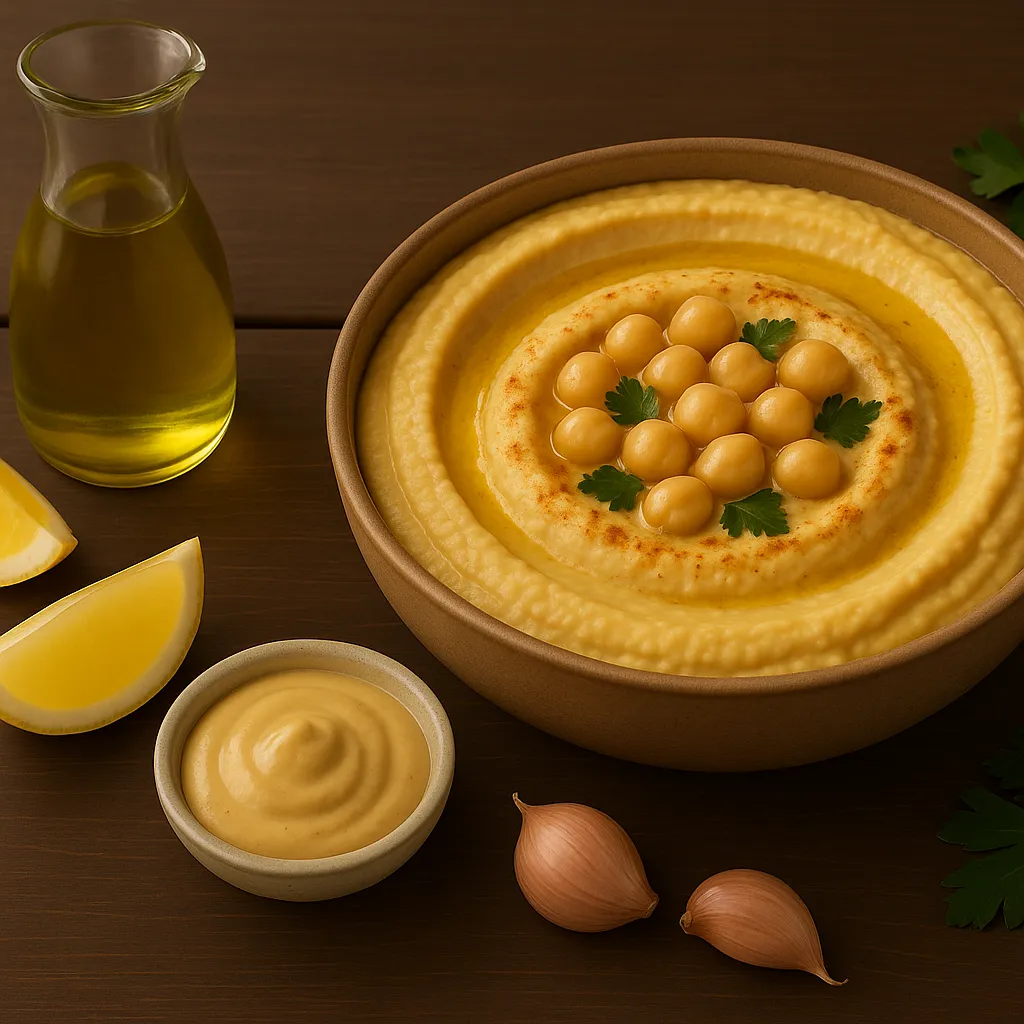There’s something special about making hummus at home. It feels wholesome, comforting, and easy. Still, many people find their homemade hummus doesn’t turn out how they imagined. The texture can be grainy. The flavor may fall flat. Worse, it often tastes nothing like the creamy, smooth dip you enjoy at Mediterranean restaurants.
But it doesn’t have to be complicated. With just a few thoughtful steps, you can create the perfect hummus recipe right in your own kitchen. No preservatives, no strange aftertaste, just good, honest ingredients blended the right way.
In this guide, I will show you how to make homemade hummus the simple way. From choosing the right chickpeas to balancing lemon juice and olive oil, every step matters. Together, we’ll make hummus that is creamy, rich, and easy enough to prepare anytime.
Ready to bring creamy hummus into your kitchen? Let’s begin.
What Makes a Great Hummus Recipe (Understanding the Basics)
Why does homemade hummus sometimes miss the mark? It’s often because the basics are overlooked. Every ingredient you choose plays a role in the final taste and texture. Let’s explore each carefully.
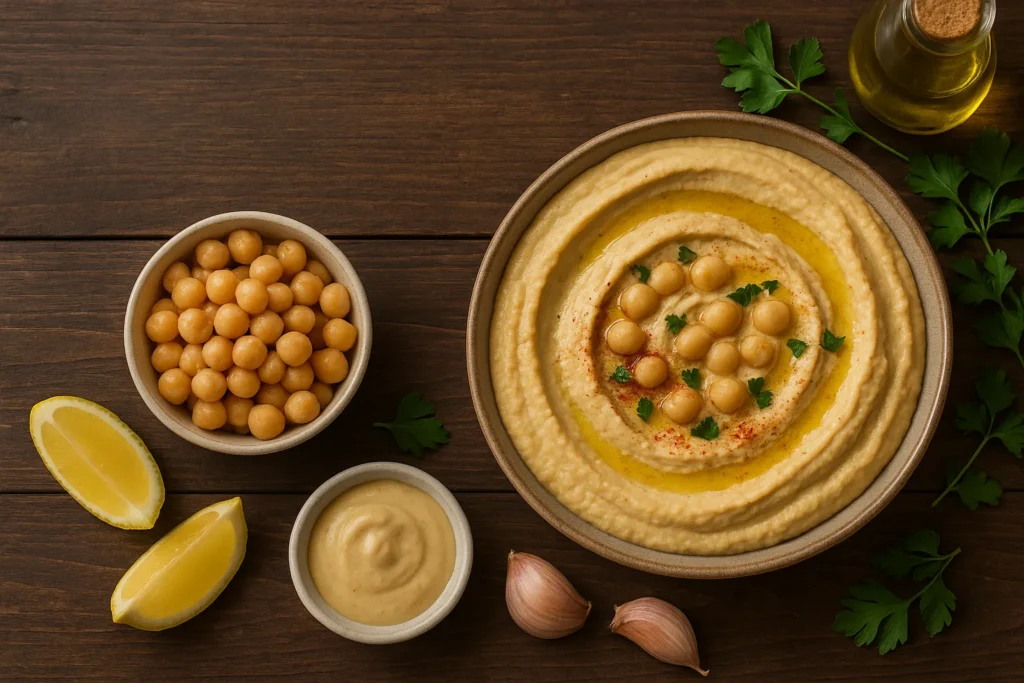
Choosing the right chickpeas matters
When it comes to chickpeas, you have options. Canned chickpeas are convenient and save time. However, if you want an edge in flavor and texture, cooking dried chickpeas makes a noticeable difference. I’ve tried both. On days when I take the time to cook dried chickpeas with a little baking soda, the result is always silkier and more satisfying.
If you stick with canned, here’s a trick I always use. Rubbing off the chickpea skins makes a huge difference. Though optional, peeling them creates a finish that feels restaurant-worthy.
Tahini brings nutty depth
Good tahini gives hummus its signature flavor and texture. I always choose one that is smooth and pourable, made from high-quality sesame seeds. Stir it well before using, since oils often separate.
Fresh lemon juice brightens everything
This isn’t the place for bottled juice. Fresh lemon juice provides crisp, clean acidity that balances richness. I usually start small and adjust. It’s easy to add more but impossible to take it out.
Garlic should never overpower
A single small garlic clove, minced or crushed, is usually enough. If you prefer a milder flavor, try my favorite tip. Soak the garlic in lemon juice for a few minutes before blending. This softens its sharpness.
Olive oil adds silkiness and depth
Adding extra virgin olive oil slowly while blending gives hummus a lovely smooth texture. Later, using a drizzle of olive oil on top makes the presentation inviting and adds extra flavor.
Your best tool: the food processor
Blenders can work, but I always reach for my food processor when making hummus. Letting it run longer helps achieve that creamy consistency. This makes homemade hummus feel truly special.
Once you have the basics covered, everything else becomes easier. Next, we’ll zoom in on one ingredient that really lifts hummus to the next level. That ingredient is lemon juice.
Lemon Juice: The Unsung Hero of Creamy Hummus
There’s a reason lemon juice always earns its place in traditional hummus. This simple ingredient is what gives hummus its signature brightness. Without it, the dip can taste dull or heavy.
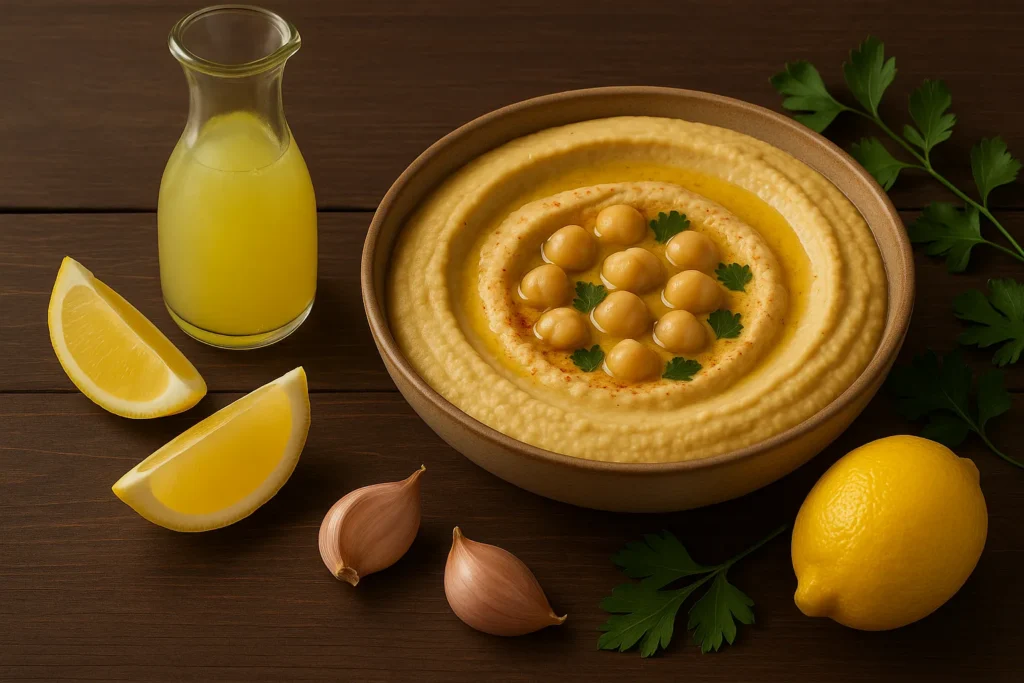
Fresh lemon juice makes a difference
Not all lemon juice is equal. Bottled versions can taste flat or artificial, which affects the overall flavor of your hummus. Always choose fresh lemon juice. It delivers a crisp, clean acidity that helps every other ingredient shine.
Here’s a simple tip. Start with less lemon juice than you think you need. Blend it in, then taste carefully. You can always add more to suit your preference. Adjusting slowly helps keep the balance just right between tahini and olive oil.
Lemon juice softens and preserves
There’s another important benefit. Lemon juice gently softens the chickpeas and tahini mixture, making it easier to create a smooth and creamy hummus. Its natural acidity also helps preserve your hummus, keeping it fresh for several days when stored in an airtight container.
Now that you understand the role of lemon juice, it is time to move on to another key player. Next, we will look at olive oil and learn how it brings richness and silky texture without weighing the hummus down.
Olive Oil: Richness Without Overpowering
In traditional Mediterranean kitchens, olive oil is never just a finishing touch. It plays a central role in balancing flavors and creating the creamy texture we all look for in homemade hummus. Without it, hummus can taste flat or feel dry on the tongue.
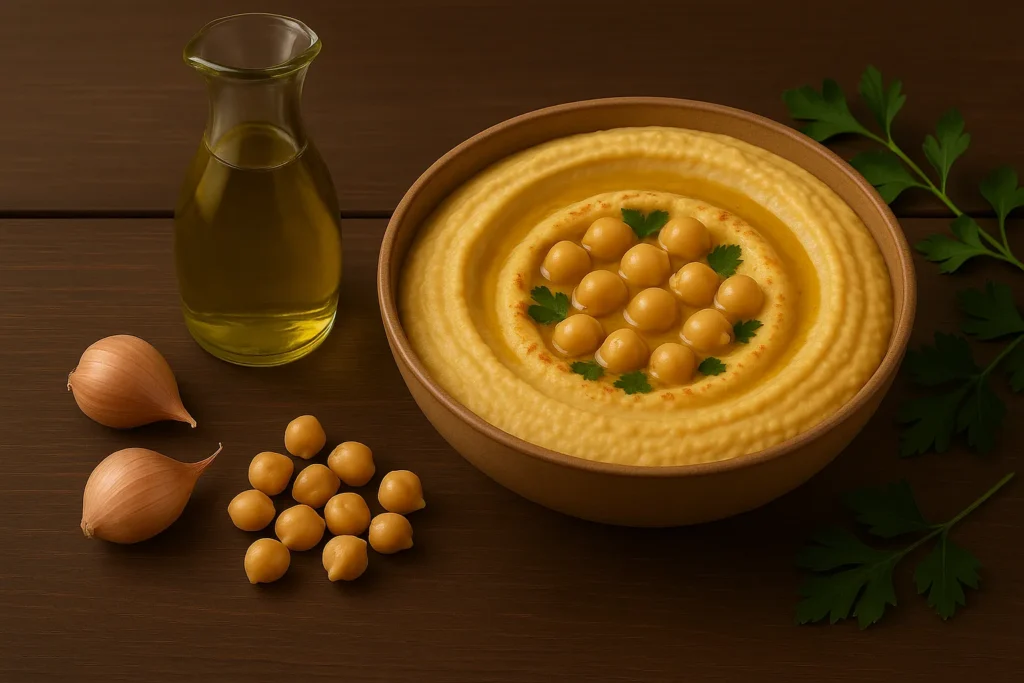
Olive oil improves texture and brings everything together
When added slowly during blending, extra virgin olive oil helps emulsify the chickpeas and tahini. This process smooths the mixture and gives hummus its soft, luxurious mouthfeel. For best results, pour it in gradually as the food processor runs. This small step creates a hummus that spreads beautifully and feels velvety with every bite.
Olive oil supports better flavor too
Beyond texture, olive oil also enhances the taste. A good quality oil brings gentle fruitiness and richness without overpowering the delicate flavors of lemon juice and chickpeas. That balance is why olive oil is celebrated across Middle Eastern cuisine. If you are curious, you can read more about its important role here.
The final touch: drizzle and serve
Once your hummus is ready, a drizzle of olive oil on top makes the presentation inviting and adds another layer of flavor. Pair it with warm pita bread or crisp fresh veggies for a snack that feels both comforting and nourishing.
Next, let’s see how spices, especially ground cumin, can elevate your hummus and give it a signature twist.
Perfect the Texture: Ground Cumin and Other Secrets
When it comes to homemade hummus, the difference between good and great often lies in the finer details. These small steps make your hummus truly special.
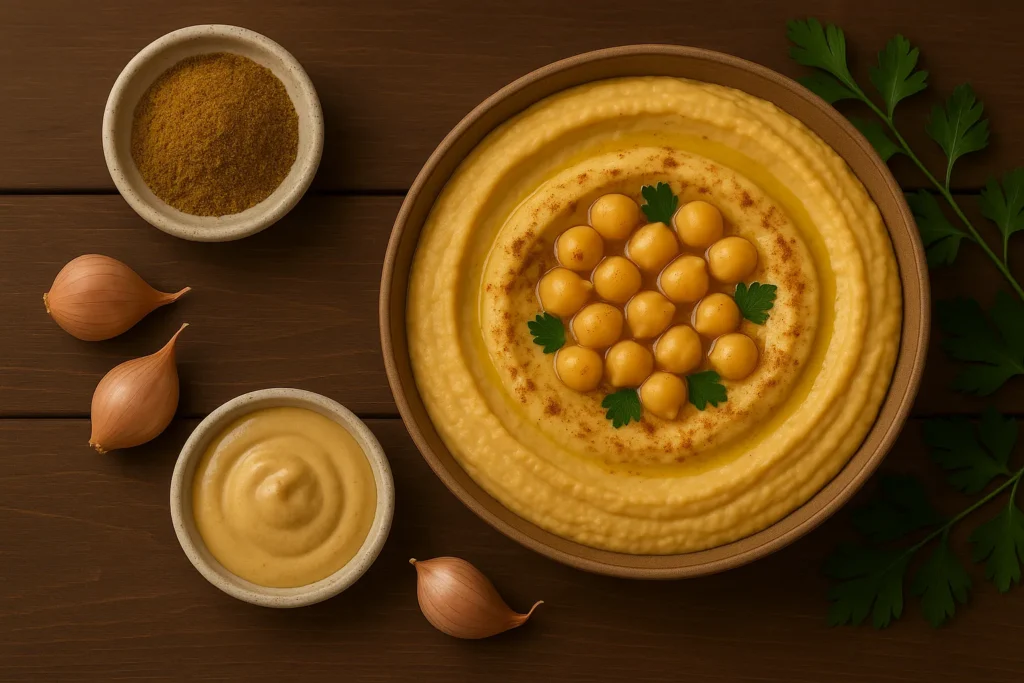
Cumin brings gentle warmth and character
While optional, ground cumin adds an earthy and subtle spice that deepens the flavor of hummus. A little goes a long way. Start with a pinch and blend it in carefully. The idea is to offer a hint of warmth without overpowering the natural flavors of chickpeas and tahini.
Peel chickpeas for extra smoothness
If you want hummus that feels silky and refined, take time to remove the chickpea skins before blending. This might sound tedious, but the payoff is worth it. Peeled canned chickpeas or cooked chickpeas result in a hummus that feels soft and luxurious.
Ice water helps achieve lightness
Instead of adding extra olive oil when blending, try pouring in ice water slowly. This technique keeps the hummus smooth while adding air, which creates a lighter, fluffier texture. It’s a simple trick, but one that makes a noticeable difference.
Blend longer than you think
For ultra-smooth hummus, allow your food processor to run for several minutes. The extra blending time breaks down the mixture completely, leaving behind no grainy bits.
With these small but meaningful steps, you’ll move from basic homemade hummus to a dip that feels polished and professional. Next, let’s explore how you can go beyond tradition and create exciting hummus variations with bold and fresh ingredients.
Hummus Variations: Get Creative and Make It Your Own
Hummus is incredibly versatile. Once you’ve mastered the basic recipe, you can experiment with various ingredients to create new flavors and textures. Here are some delightful variations to inspire your next batch:
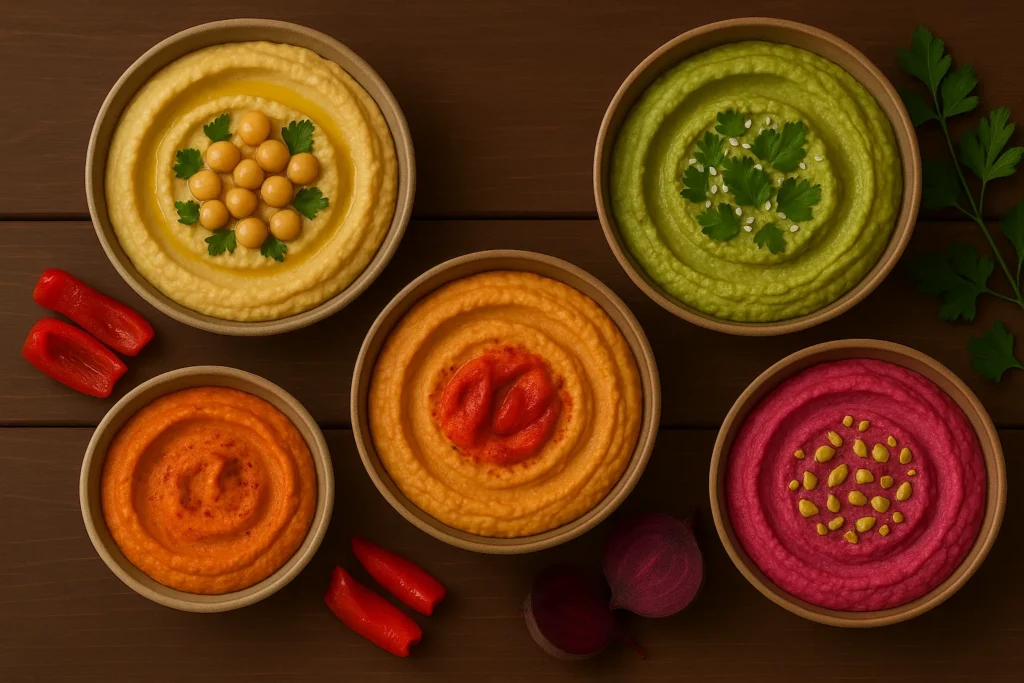
Roasted Red Pepper Hummus
Adding roasted red peppers introduces a sweet and smoky flavor to your hummus. Simply blend in a few roasted peppers with your standard ingredients. This variation pairs wonderfully with pita chips or as a spread on sandwiches.
Beet Hummus
For a vibrant twist, incorporate roasted beets into your hummus. The beets not only provide a stunning color but also add a subtle sweetness. It’s a great way to impress guests at gatherings.
Avocado Hummus
Mixing ripe avocados into your hummus results in a creamy, rich dip with a hint of freshness. This variation is perfect for those who enjoy the buttery texture of avocados.
Spicy Sriracha Hummus
If you like a bit of heat, adding sriracha sauce to your hummus can give it a spicy kick. Adjust the amount to suit your taste, and enjoy it with crunchy vegetables or crackers.
Herbed Hummus
Incorporate fresh herbs like parsley, cilantro, or basil into your hummus for an aromatic and refreshing flavor. This variation is especially delightful during the spring and summer months.
For more inspiration, check out this collection of unique hummus recipes on Wikipedia.
Note: Feel free to experiment with other ingredients like sun-dried tomatoes, caramelized onions, or even different legumes like black beans or lentils to create your own signature hummus.
Next, we’ll explore how to serve and store your homemade hummus to maintain its freshness and flavor.
Serving and Storing Hummus the Right Way
There’s something special about a freshly made bowl of hummus. Its creamy texture and rich taste are best enjoyed right after blending. But what if you make extra or want to serve it later? Knowing how to store and present hummus properly ensures it stays delicious and safe to eat.
Serve hummus creatively and thoughtfully
Hummus isn’t just for dipping. Of course, pita bread, pita chips, and fresh veggies are always welcome, but don’t stop there. Spread hummus on sandwiches, use it as a base for salad dressings, or add a dollop to grain bowls. You can even pair it with roasted vegetables or use it in wraps. (I often keep a small container in the fridge just for easy weekday lunches.)
Before serving, always give hummus a gentle stir. If it has thickened slightly in the fridge, adding a splash of water or lemon juice can quickly revive its creamy consistency.
Store hummus for freshness and safety
Homemade hummus should be stored in an airtight container and kept in the refrigerator. It stays fresh for about five to seven days. To prevent drying out, smooth the top and add a thin drizzle of olive oil before sealing. This layer protects the surface from air exposure.
If you’ve made a large batch and want to save some for later, freezing is a handy option. Transfer the hummus to freezer-safe containers, leaving a little space for expansion. It can be kept frozen for up to three months. When ready to use, thaw it in the refrigerator overnight and stir well. For texture, adding a touch of olive oil after thawing helps restore its smoothness.
For food safety guidelines on storing dips like hummus, visit Food Safety.gov.
Once your hummus is stored safely, you can always bring it back to life with a few easy touches. In the final section, let’s wrap up with simple tips to avoid common mistakes and make the best hummus every single time.
Avoiding Common Mistakes When Making Hummus
Even though hummus is simple at its core, small mistakes can make it turn out bland, too thick, or gritty. The good news? These are easy to avoid once you know what to watch for.
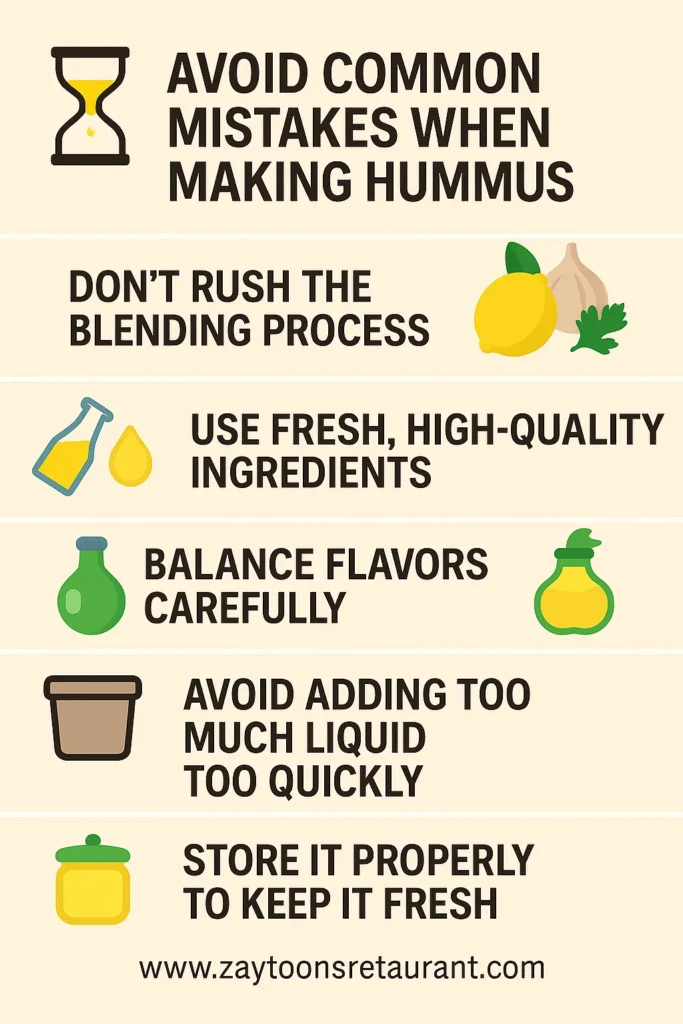
Don’t rush the blending process
Smooth and creamy hummus doesn’t happen instantly. If you stop the food processor too early, you’ll end up with a rough, uneven texture. Let it run longer than you think. The mixture should look silky and uniform when it’s done. (If you’re wondering, yes, giving it extra time really does make a huge difference.)
Use fresh, high-quality ingredients
Using old or poor-quality ingredients can make hummus taste flat. Always opt for fresh lemon juice, good-quality tahini, and extra virgin olive oil. Chickpeas should be soft and cooked properly, whether using canned chickpeas or those made from scratch.
Balance flavors carefully
Too much garlic, tahini, or lemon juice can overpower the delicate balance of flavors. Start with small amounts, then taste and adjust as you go. It’s easier to add more than to fix an overly strong batch.
Avoid adding too much liquid too quickly
When your hummus feels thick, it’s tempting to add lots of water or olive oil right away. Instead, add liquid slowly and in small amounts. This helps you control the texture and avoid ending up with watery hummus.
Store it properly to keep it fresh
Neglecting proper storage can ruin even the best batch. Always transfer leftover hummus to an airtight container, smooth the top, and add a thin layer of olive oil before sealing. This keeps it from drying out and helps maintain that creamy texture.
Hummus should be easy and satisfying to make at home. With these simple tips and a little practice, you’ll avoid the common pitfalls and create the kind of hummus that draws compliments every time.
Up next, we’ll bring everything together with a short and friendly wrap-up that encourages you to enjoy your homemade hummus often and with confidence.
Enjoy Homemade Hummus with Confidence
Homemade hummus tastes fresher and feels more rewarding than anything from the store. Using simple ingredients like fresh lemon juice, quality extra virgin olive oil, and tender cooked chickpeas, you can create a creamy, flavorful dip that’s easy to make anytime.
Add your own twist with roasted vegetables, herbs, or spices. Every batch offers a chance to try something new and delicious.
Ready to bring these ideas to life in your own kitchen? Visit Zaytoons Restaurant for more Mediterranean inspiration and recipes you’ll love.

